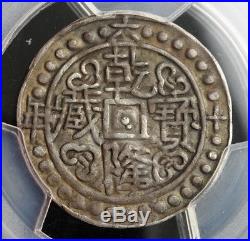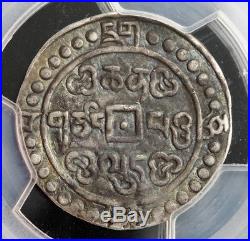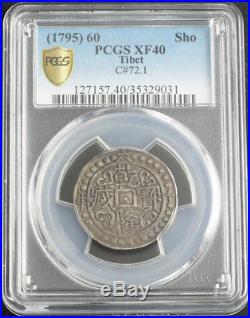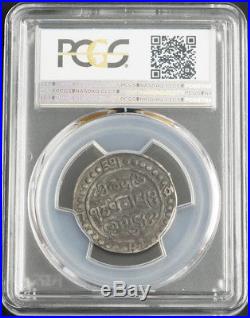1795, Tibet, Qian Long. Silver Sino-Tibetan Sho Coin. Doubled dot! PCGS XF-40





Denomination: 1 Sho Mint year: 1795 (CD60) Reference: L&M-636, WS-0205, Cr-72.1. Certified and graded by PCGS as XF-40! Diameter: 25mm Material: Silver Weight: 6.7gm. Obverse : Central square element imitating the holing of Chinese cast cash-coins with a dot here the dot is doubled! In center, surrounded by four Chinese characters and decorative ornaments.
Two characters at sides, one above and 30 dots around. Reverse : Central square element imitating the holing of Chinese cast cash-coins with a dot in center.
Tibetan inscription in fields, two characters at sides, two groups of two characters above and below and 24 dots around. A few coins from other countries were also occasionally in use. Coins were first used in a more extensive way in the 17th century: these were silver coins supplied by Nepal. There were however various difficulties with this system. In 1763/64 and 1785 the first silver coins were struck in Tibet.In 1792 the first mass-produced silver coins were created under joint Chinese and Tibetan authority. Coins bearing Tibetan inscriptions only were subsequently replaced by issues which had Chinese and Tibetan legends. This lasted until the 1830s. In 1791 it was originally planned by the Chinese authorities to cast copper cash coins in Tibet.
Had this plan been carried out, the Tibetan coinage could have become part of the Chinese currency system. But this plan was abandoned because it was found to be too expensive to transport copper from China to Tibet in order to cast cash coinage in Lhasa.
Between 1791 and 1836 the Tibetan currency was largely decided on by the Chinese government in consultation with Tibetan authorities, and silver coins were struck to the sho (zho) standard i. About 3.7 grams in the 58th, 59th and 60th year of Qianlong (1793, 1794 and 1795). The Qianlong Emperor (25 September 1711 7 February 1799) was the sixth emperor of the Manchu-led Qing dynasty, and the fourth Qing emperor to rule over China proper. Born Hongli , the fourth son of the Yongzheng Emperor, he reigned officially from 11 October 1735 to 8 February 1796.1 On 8 February, he abdicated in favour of his son, the Jiaqing Emperor a filial act in order not to reign longer than his grandfather, the illustrious Kangxi Emperor. [1] Despite his retirement, however, he retained ultimate power as the Emperor Emeritus (or Retired Emperor) until his death in 1799; he thus was the longest-reigning.Ruler in the history of China, and dying at the age of 87, the longest-living. As a capable and cultured ruler inheriting a thriving empire, during his long reign the Qing Empire reached its most splendid and prosperous era, boasting a large population and economy. As a military leader, he led military campaigns expanding the dynastic territory to the largest extent by conquering and sometimes destroying Central Asian kingdoms.
This turned around in his late years: the Qing empire began to decline with corruption and wastefulness in his court and a stagnating civil society. A British valet who accompanied his diplomat master to the Qing court in 1793 described the emperor. The Emperor is about five feet ten inches in height, and of a slender but elegant form; his complexion is comparatively fair, though his eyes are dark; his nose is rather aquiline, and the whole of his countenance presents a perfect regularity of feature, which, by no means, announce the great age he is said to have attained; his person is attracting, and his deportment accompanied by an affability, which, without lessening the dignity of the prince, evinces the amiable character of the man. His dress consisted of a loose robe of yellow silk, a cap of black velvet with a red ball on the top, and adorned with a peacock's feather, which is the peculiar distinction of mandarins of the first class. He wore silk boots embroidered with gold, and a sash of blue girded his waist.
The item "1795, Tibet, Qian Long. PCGS XF-40" is in sale since Monday, May 14, 2018. This item is in the category "Coins & Paper Money\Coins\ World\Asia\China\Empire (up to 1948)". The seller is "coinworldtv" and is located in Europe. This item can be shipped worldwide.
- Certification: PCGS
- Grade: XF40
- Certification Number: 35329031
